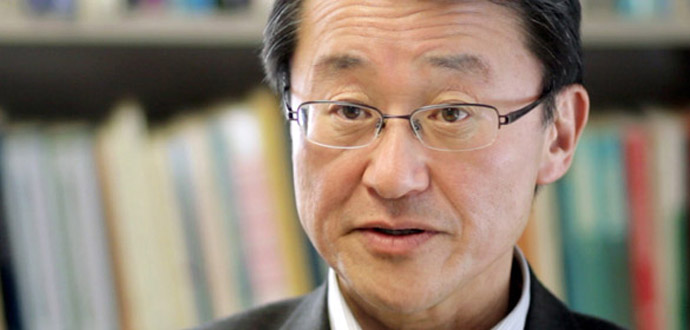
In Japan, one of the biggest cultural events of the year is called Tanabata, or the Star Festival. According to the legend, two young lovers are reunited by crossing a bridge made from the wings of flying birds. Selecting the Star Festival as backdrop for his award-winning multimedia project was a fitting choice for MIT Professor of Linguistics, Shigeru Miyagawa. His own academic career has bridged many different worlds: Japan and America, linguistics and culture, education and technology.
Miyagawa grew up in the coastal town of Hiratsuka, between Tokyo and Mount Fuji, until the age of ten. When his father, a professor of physics, accepted a teaching position in the United States, the family relocated to Duke University, then permanently resettled at the University of Alabama. Miyagawa remembers those years in late-sixties Alabama as especially challenging. “I often felt lonely and isolated. This was a state with few foreigners, and racial tensions were already high. There were no Japanese other than my family, there was no Japanese food. The only other Japanese person I ever encountered was Mr. Sulu on Star Trek.”
Miyagawa nonetheless adapted to his new life in the United States. By middle school, he spoke fluent English, and he excelled in math and science throughout high school. “I spent a lot of time in my father’s lab making models and airplanes as a kid,” he remembers, “I made a transistor radio, and an electric generator that won the school science fair.” Yet when it came to choosing a university, Miyagawa decided to return to his native Japan. Once there, however, he quickly discovered that he was “neither Japanese nor American. I was neither and I was both.”
You could take sentences apart and lay all their parts on a table, like clockwork. It’s the most fascinating thing in the world—I honestly don’t understand why everyone doesn’t study it.
Straddling two worlds has remained a recurring theme for Miyagawa. For example, early in his undergraduate career he made the decision to focus on the humanities. “Although I was very good in math, physics and chemistry, I decided that I did not want to pursue the same path as my father,” he confesses, “So one day I simply walked across campus and began taking humanities classes.” While he greatly enjoyed the creative writing program that he initially entered, it was the discovery of linguistics that truly captured his imagination. “For me, it was the perfect combination of language and science. You could take sentences apart and lay all their parts on a table, like clockwork. It’s the most fascinating thing in the world—I honestly don’t understand why everyone doesn’t study it,” he says, and one senses that he’s only half-joking.
After completing a Ph.D. in Linguistics at the University of Arizona, and following a decade of teaching at the Ohio State University, Miyagawa joined the MIT Department of Linguistics and Philosphy and also Foreign Languages and Literatures. His passion for language shines through in his description of its fundamental questions. “There are 7,000 to 8,000 languages in the world, possibly more, depending on how you count them. Where do they all come from? Well, what we’ve seen is that there are many underlying similarities in language, which may be traced to how language is encoded in our minds. For example, when we listen to music, our ears pick up the tiniest differences in a note. But with language, we are much more forgiving. Instead of hearing these small differences, we hear much broader categories of sounds. That simple feature is what allows us to communicate with each other despite our different voices and styles of pronunciation. Language is fundamentally different from noise and music—because it’s processed in a different part of the brain.”
Yet linguistics represents only a portion of Miyagawa’s varied career. He is also a Professor of Japanese Language and Culture, the Head of Foreign Language and Literature at MIT, and a tireless supporter of using technology to advance education. Since the earliest days of the Web, he has worked to realize its potential as a tool for teaching and learning: Back in 1993, well before the popularization of the Internet, Miyagawa put the entire MIT Japanese language program on the Internet, in order to help students master Japanese quicker and more efficiently. With the rise of multimedia, Miyagawa created the interactive Star Festival tool, to help students explore Japanese culture. It’s been used in hundreds of classrooms throughout the Boston area, and in a poetic twist, George Takei, whose role as Mr. Sulu in Star Trek once consoled the young Miyagawa, became Star Festival’s narrator. More recently, Miyagawa collaborated with Pulitzer Prize-winning author John Dower to create Visualizing Cultures, a stunning visual archive of various chapters in Japanese history.
These ventures in digital learning led MIT’s President Chuck Vest to include him on the original faculty committee that recommended the creation of OCW in 2001. He recalls that, “At the time, everyone’s early assumptions were that we would create a ‘MIT.com’ for teaching. But as we reviewed the scenarios, and started crunching the numbers, people started asking whether it was right to connect teaching materials to revenue. Of course we considered many different business models, but once we decided that we should give away the content, there was something very deep about MIT’s values that surfaced. I felt it and I think everyone else felt it.”
Now Miyagawa is Chair of the MIT OpenCourseWare Faculty Advisory Committee, and a vocal supporter of its continued importance. “To be able to offer teaching materials through OCW is one of the best things that can happen to you as a teacher. It’s like hitting the lottery to touch so many people through your teaching. It’s also good,” he smiles, “because it keeps you on your feet, knowing that tens of thousands people might be watching.”